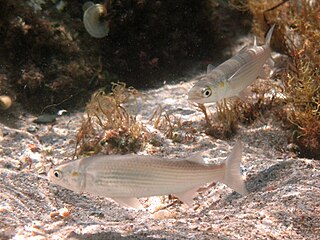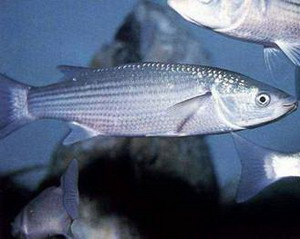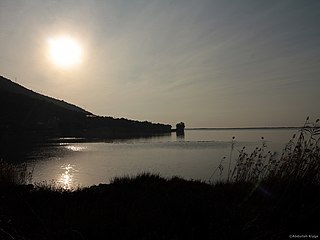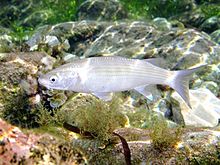
The white perch is not a true perch but is a fish of the temperate bass family, Moronidae, notable as a food and game fish in eastern North America. In some places it is referred to as "Silver Bass".

The round goby is a euryhaline bottom-dwelling species of fish of the family Gobiidae. It is native to Central Eurasia, including the Black Sea and the Caspian Sea. Round gobies have established large non-native populations in the Baltic Sea, several major Eurasian rivers, and the North American Great Lakes.

Myxobolus is a genus of myxozoa that includes important parasites of fish like Myxobolus cerebralis. The genus is polyphyletic, with members scattered throughout the myxozoa. Some stages of Myxobolus species were previously thought to be different organisms entirely, but are now united in this group. Some fish species, such as the thicklip grey mullet, can harbour a dozen of Myxobolus species.

The flathead grey mullet is an important food fish species in the mullet family Mugilidae. It is found in coastal tropical and subtropical waters worldwide. Its length is typically 30 to 75 centimetres. It is known with numerous English names, including the flathead mullet, striped mullet, black mullet, bully mullet, common mullet, grey mullet, sea mullet and mullet, among others.
Grey mullet can mean any of several fish in the family Mugilidae and having a greyish hue:

Yellow-eye mullet, also known as Coorong mullet, conmuri, estuary mullet, Forster's mullet, freshwater mullet, pilch, pilchard, Victor Harbor mullet, yelloweye, yellow-eyed mullet known are small, near-shore fish found in temperate waters of southern Australia from just north of Sydney, New South Wales to Shark Bay in Western Australia, around Tasmania, and New Zealand.

The Lessepsian migration is the migration of marine species across the Suez Canal, usually from the Red Sea to the Mediterranean Sea, and more rarely in the opposite direction. When the canal was completed in 1869, fish, crustaceans, mollusks, and other marine animals and plants were exposed to an artificial passage between the two naturally separate bodies of water, and cross-contamination was made possible between formerly isolated ecosystems. The phenomenon is still occurring today. It is named after Ferdinand de Lesseps, the French diplomat in charge of the canal's construction.
Chelon is a genus of mullets found in coastal marine waters, estuaries and rivers in the Atlantic Ocean and Arabian Sea.
The Otomebora mullet, the giantscale mullet or St Lucia mullet, is a species of fish in the family Mugilidae. It is found in the Indo-Pacific Region.

Boops boops, commonly called the bogue, is a species of seabream native to the eastern Atlantic. Its common name in most languages refers to its large ("bug") eyes.

The golden grey mullet is a fish in the family Mugilidae.

The thinlip mullet is a species of fish in the family Mugilidae. It is found in shallow European waters and is a migratory species.

The leaping mullet is a species of fish in the family Mugilidae. It is found in coastal waters and estuaries in the northeast Atlantic, ranging from Morocco to France, and including the Mediterranean and Black Sea. It has been introduced to the Caspian Sea.

Percopsis omiscomaycus, also known as the trout-perch, the grounder or the sand minnow, is one of two species in the family Percopsidae. Its name comes from the Greek root words perc, meaning perch and opsi meaning appearance. The species name omiscomaycus is thought to be derived from a Native American word meaning trout. These are freshwater fish that prefer clear to slightly turbid water, and are found in rivers and lakes throughout North America. They are a generally small fish found in deep waters by day, but which migrate to shallower waters at night.They are most often seen washed up on beaches and are rarely seen alive or correctly identified. The trout-perch possess characteristics similar to both the trout and the perch. They are an important source of food for many predator fish such as walleye, northern pike, and lake trout. They are not a major human fishery, but are occasionally used as a bait fish.

The white sucker is a species of freshwater cypriniform fish inhabiting the upper Midwest and Northeast in North America, but it is also found as far south as Georgia and as far west as New Mexico. The fish is commonly known as a "sucker" due to its fleshy, papillose lips that suck up organic matter and aufwuchs from the bottom of rivers and streams.
Chelon bispinosus is a fish of the family Mugilidae. It is one of seven species in the genus Chelon. It is endemic to waters near Cape Verde in the east central Atlantic Ocean. This species is found in the neritic zone.

Planiliza carinata, the keeled mullet, is a species of grey mullet from the family Mugilidae which is found in the western Indian Ocean and eastern Mediterranean Sea. It colonised the Mediterranean by Lessepsian migration from the Red Sea through the Suez Canal. The keeled mullet is a species of minor importance in commercial fisheries.

Beymelek Lagoon is a lagoon on the Mediterranean coast, which is used as a fishery, in Antalya Province, southwestern Turkey. It is named after the village of Beymelek, which is located to the west of the water body. It is situated in Demre ilçe (district) of Antalya Province at 36°16′N30°03′E.
The Diassanga mullet is a species of ray-finned fish, grey mullet from the family Mugilidae. It is found in the eastern Atlantic around the coasts of West Africa.

The grooved mullet is a species of ray-finned fish, a grey mullet from the family Mugilidae. It is found in the coastal waters of the eastern Atlantic Ocean off the western coast of Africa, as far north as Mauritania, and into the western Indian Ocean.

















